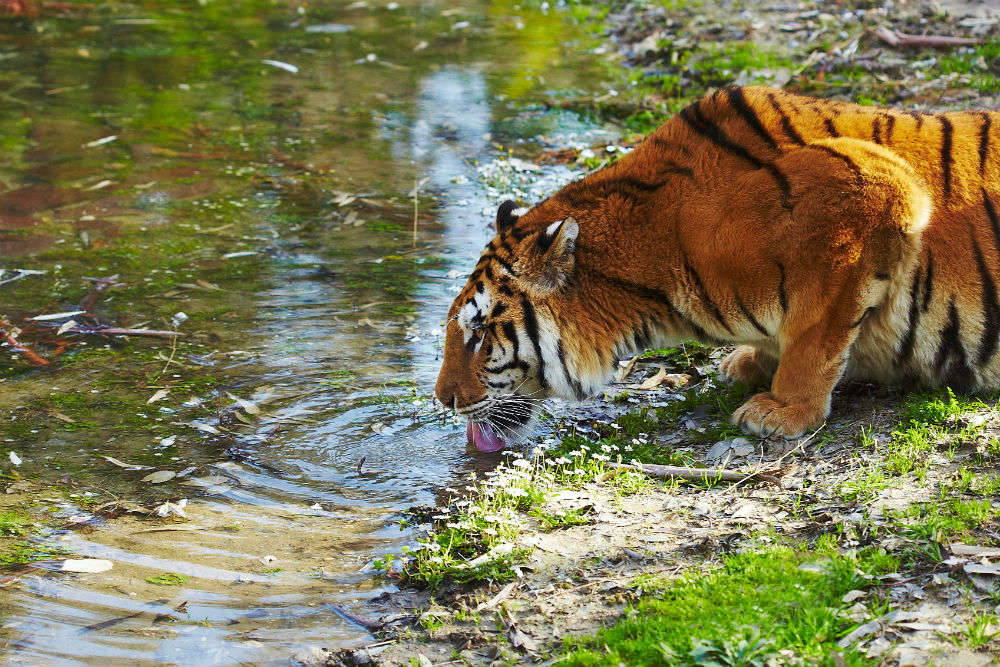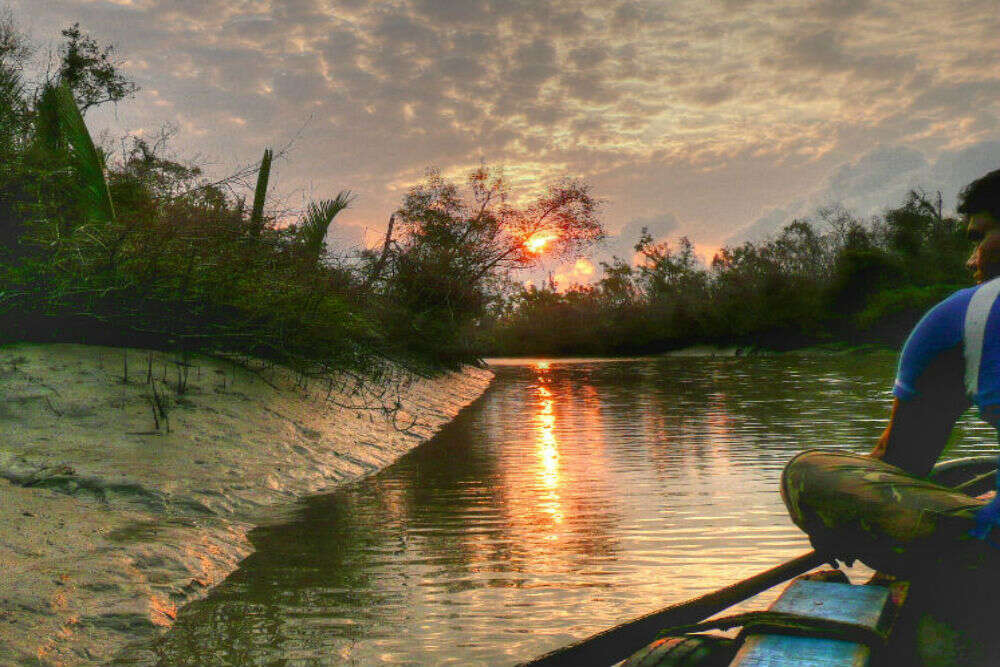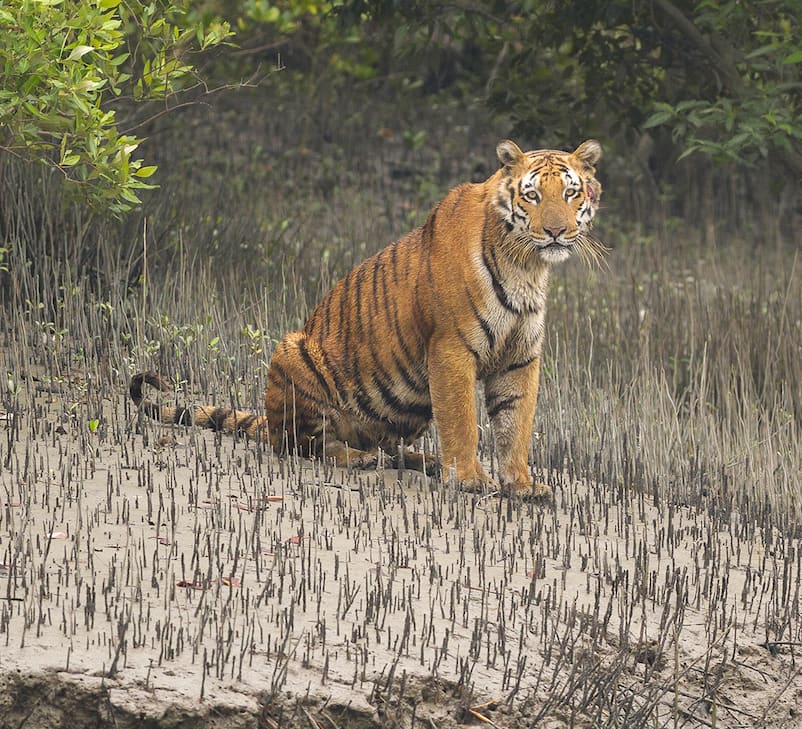Endangered Bengal Tiger: The Sundarbans in Bangladesh, the world’s biggest mangrove forest and a safe refuge for endangered animals like the Bengal tiger, have been designated as a World Heritage site by the United Nations. 1 UNESCO’s World Heritage Committee, on the other hand, has been deafeningly silent in the face of two proposed coal plants that will endanger this fragile environment, its animal residents, and the people who rely on it.

The Sundarbans mangrove forest, one of the world’s biggest (140,000 acres), is located on the Bay of Bengal’s Ganges, Brahmaputra, and Meghna river deltas. It is located near the Sundarbans World Heritage Site in India, which was listed as a UNESCO World Heritage Site in 1987.
A complex network of tidal rivers, mudflats, and tiny islands of salt-tolerant mangrove forests across the site serves as an excellent illustration of continuous natural processes. The area is renowned for its diverse biodiversity, which includes 260 different bird species, the Bengal tiger, and other endangered animals like the estuarine crocodile and the Indian python.
Read More:
Brief synthesis
The Sundarbans Reserve Forest (SRF) is the world’s biggest contiguous mangrove forest, located in Bangladesh’s southwest between the river Baleswar in the east and the Harinbanga in the west, next to the Bay of Bengal. With a total area of 10,000 km2 and latitudes of 21° 27′ 30′′ and 22° 30′ 00′′, North and longitudes of 89° 02′ 00′′ and 90° 00′ 00′′ East, 60 per cent of the property is in Bangladesh and the rest in India. The terrestrial area, including exposed sandbars, covers 414,259 hectares (70%) of the total area, while water bodies occupy 187,413 ha (30 per cent).

The three wildlife sanctuaries in the south span 139,700 hectares and are important breeding grounds for a variety of endangered species. It is a landmark of the ancient legacy of mythical and historical events, located in a unique bioclimatic zone inside a characteristic geographical position in the coastal region of the Bay of Bengal. It is widely known for its great biodiversity of mangrove flora and animals on land and sea, as well as its spectacular visual beauty and natural riches.
In actuality, Bangladesh’s Sundarbans Forest Reserve is a patchwork of islands of all forms and sizes, perpetually washed by brackish water shrieking in and around the unending and mind-boggling labyrinths of water canals. In its terrestrial, aquatic, and marine environments, the park sustains great biodiversity, spanning from micro to macro flora and animals.

The Royal Bengal Tiger, Ganges and Irawadi dolphins, estuarine crocodiles, and the critically endangered unique river terrapin all call the Sundarbans home (Batagur Baska). Panthera tigris Tigris species has only one mangrove habitat on the planet. Let’s know more about SThe endangered Bengal tiger calls the UNESCO World Heritage Site the Sundarbans home. What exactly are the Sundarbans 2022 ?
Criterion (ix):
The Sundarbans reflect the process of delta creation and colonisation of newly produced deltaic islands and associated mangrove communities, and hence constitute an important example of ongoing biological processes. Monsoon rains, flooding, delta formation, tidal influence, and plant colonisation are all examples of these processes.
The land has been shaped by tidal action, resulting in distinct physiology, as part of the world’s biggest delta, produced from sediments deposited by three great rivers: the Ganges, Brahmaputra, and Meghna, and covers the Bengal Basin. Let’s know more about The endangered Bengal tiger.
Criterion (x):
The Sundarbans, one of the world’s largest remaining mangrove forests, supports a high level of biodiversity in both the terrestrial and marine environments, including significant populations of globally endangered cat species such as the Royal Bengal Tiger. Royal Bengal Tiger population censuses estimate a population of 400 to 450 individuals, the highest density of any tiger population in the world.
For a vast diversity of faunal species, the property is the sole surviving habitat in the lower Bengal Basin. Its high richness is exhibited in a wide spectrum of flora; 334 plant species belonging to 245 genera and 75 families, 165 algae and 13 orchid species. It also has diverse biodiversity, with 693 species including 49 mammals, 59 reptiles, 8 amphibians, 210 white fishes, 24 shrimps, 14 crabs, and 43 molluscs. One of the property’s most appealing features is the diverse and colourful birdlife found along its canals, which includes 315 species of waterfowl, raptors, and woodland birds, including nine species of kingfisher and the beautiful white-bellied sea eagle.
Integrity
The Sundarbans are the region’s largest delta, backwater, and tidal phenomena, providing a broad range of habitats for hundreds of aquatic, terrestrial, and amphibian species. With all important assets contained within the borders, the site is large enough to effectively depict its significant floral and faunal variety.

The site encompasses the full panorama of mangrove ecosystems, as well as an appropriate surrounding region of aquatic (both marine and freshwater) and terrestrial habitats, and hence all areas critical to the Sundarbans’ long-term protection and unique biodiversity.
The World Heritage site is made up of three wildlife sanctuaries that serve as the primary breeding grounds for a variety of endangered species. The property also includes areas of outstanding natural beauty, ethnobotanical interest, exceptional marine faunal interest, rivers, streams, islands, swamps, estuaries, mudflats, and tidal flats. Let’s know more about The endangered Bengal tiger calls the UNESCO World Heritage Site the Sundarbans home. What exactly are the Sundarbans 2022 ?

All major mangrove vegetation types, areas of high floral and faunal value, and important bird areas are all protected within the property’s boundaries. Terrestrial and aquatic buffer zones that surround but are not part of the inscribed property add to the property’s integrity.
Natural disasters, like cyclones, have always constituted a threat to the property’s value, and they, along with salty water incursion and siltation, continue to be possible hazards to the characteristics. Cyclones and tidal waves harm the forest near the sea-land interface and have previously resulted in significant mortality among some fauna species, such as spotted deer.
Overexploitation of the property’s wood and wildlife resources, illegal hunting and trapping, and agricultural encroachment all pose major challenges to the property’s values and general integrity.
Protection and management requirements

Since the early nineteenth century, the property has had effective national legislative protection for its land, woodland, and aquatic environment, which is made up of three nature sanctuaries. After being means of different as forest reserves in 1878, the three wildlife sanctuaries were formed in 1977 under the Bangladesh Wildlife (Preservation) (Amendment) Act, 1974. Let’s know more about The endangered Bengal tiger. Let’s know more about The endangered Bengal tiger.
The Bangladesh Wildlife (Preservation) (Amendment) Act 1974, together with the Forest Act of 1927, regulates activities such as entry, movement, fishing, hunting, and the exploitation of forest products. Sundarbans West has a number of field stations that help provide amenities for management employees. Within the restricted forest, there are no established appropriate rights, and entrance and collection of forest products are subject to permits given by the Forest Department. Let’s know more about The endangered Bengal tiger.
The property is now well-managed and monitored on a regular basis by defined management norms, regular employees, and administrative units. The main goal of management is to keep the property’s biodiversity, aesthetic qualities, and integrity intact. To preserve and assist the property’s biological process on a long-term basis, a careful balance is required.
Another important management goal is the preservation of current ecological and hydrological processes, which may be endangered if ongoing development activities outside the land were to harm them. Since its declaration as a reserved forest, the area has been subjected to a series of increasingly comprehensive management plans, with one of the main focuses of many of these plans being the management of tigers and other wildlife as an integral part of forest management that ensures the sustainable harvesting of forest products while maintaining the coastal zone in a way that meets the needs of the local human population.
The Sundarbans working plans show a gradual improvement in knowledge of management needs and the complexity of prescriptions made to satisfy them. Let’s know more about The endangered Bengal tiger.

The species and environment of the Sundarbans have been studied extensively. The creation of working plans for the land, concentrating on animal conservation and management, has benefited from international input and cooperation from WWF and the National Zoological Park, the Smithsonian Institution, and other organisations.
Millions of people reside in the Sundarbans, which operate as a shelter belt to protect them from storms, cyclones, tidal surges, seawater seepage, and encroachment. During particular seasons, the land provides labour for a huge number of people living in tiny villages surrounding the property, who work as woodcutters, fishermen, honey gatherers, leaves and grass gatherers, among other things. Let’s know more about The endangered Bengal tiger.
Due to limited access, transportation arrangements, and a lack of amenities, particularly sufficient lodging, tourism numbers remain low. The effects of mass tourism are unlikely to have an influence on the property’s value. While the property’s legal protection prevents a variety of activities inside its bounds, illicit hunting, wood extraction, and agricultural encroachment are all possible threats to the property’s value. Storms, cyclones, and tidal surges up to 7.5 metres high are all-natural aspects of the area, but they also constitute a hazard that may become more frequent as a result of climate change.
The annual meeting of the World Heritage Committee begins on July 10th. Unlike the Committee, we will not remain mute as the Sundarbans’ main river is dredged to make space for coal boats. The Sundarbans will be formally listed as a threatened site by the UNESCO World Heritage Committee.
UNESCO must conserve this important monument rather than permitting two very dangerous coal-fired power stations to be built. UNESCO may press Bangladesh and India to abandon plans for coal-fired power projects in the Sundarbans and instead commit to clean, renewable energy and long-term development. The Sundarbans must be declared endangered by coal by UNESCO’s World Heritage Committee.
And the Sundarbans are undoubtedly in jeopardy. The coal plants’ smokestacks would release mercury, acid gases, and other hazardous pollutants into the World Heritage site, endangering nearby populations, mangrove forests, and everything that depends on them, including the endangered Bengal tiger.

We have Sundarban Tour Packages Daily Basis.
For Booking Of Best Sundarban Package (Starting from 2799/-)
Explore the Sundarban on a 3-day jungle adventure boat tour from Kolkata. With a local guide, cross the ganga by speedboat and arrive at a jungle lodge near the village of Gosaba. Set out after dark to see alligators and other nocturnal nightlife in the jungle. Trek through the forest with a nature guide to learn about medicinal plants and their traditional uses. Learn about the traditional farming methods during a visit to a local indigenous tribe.
Royal Sundarban Tourism
Visit: https://tinyurl.com/y6smhoup
Contact: 7439965413 / 8584838109
Whats app link : https://tinyurl.com/yxtvhcs3
Email: info@royalsundarbantourism.com
Address: Sundarban. Gosaba Market Durga Mandir Road, Pin – 743370, West Bengal, India


